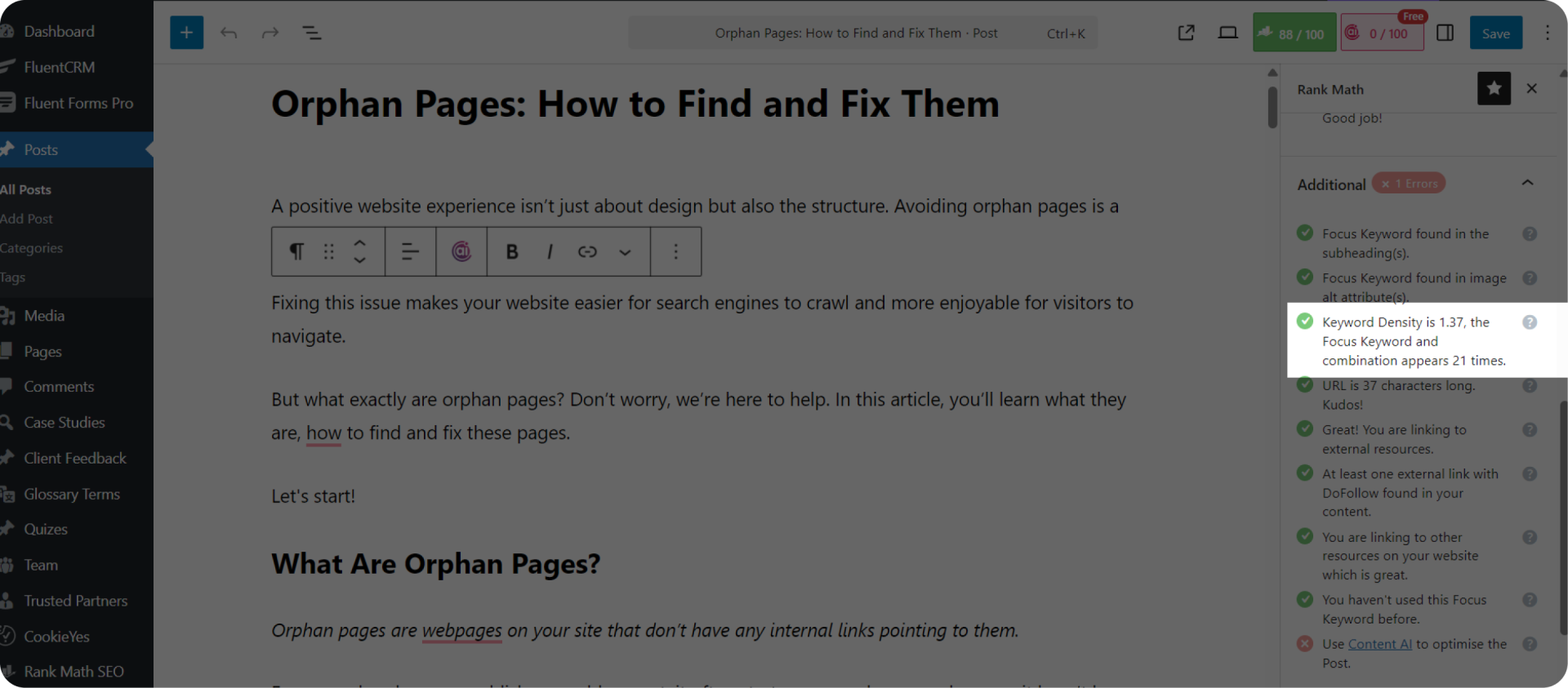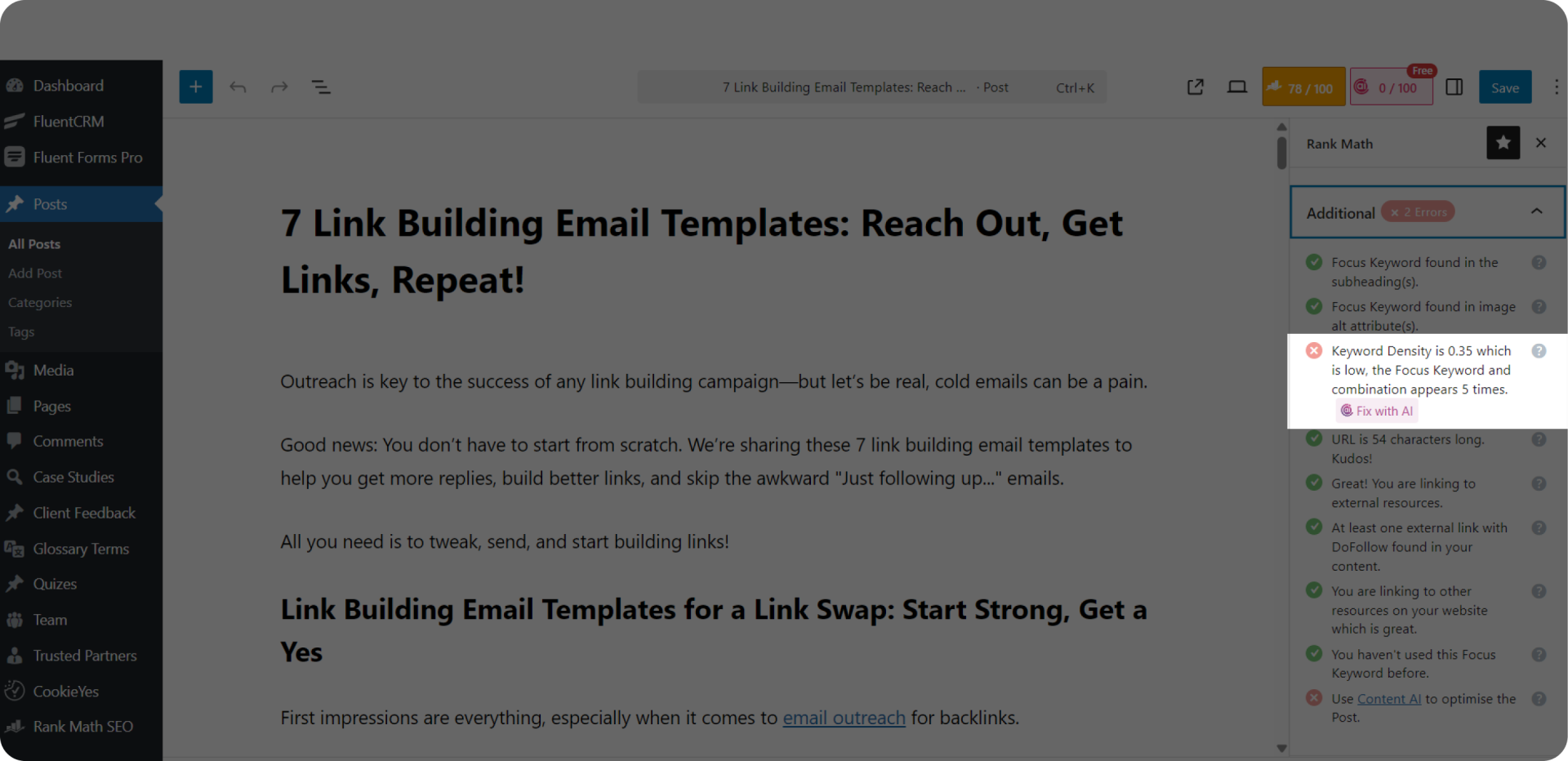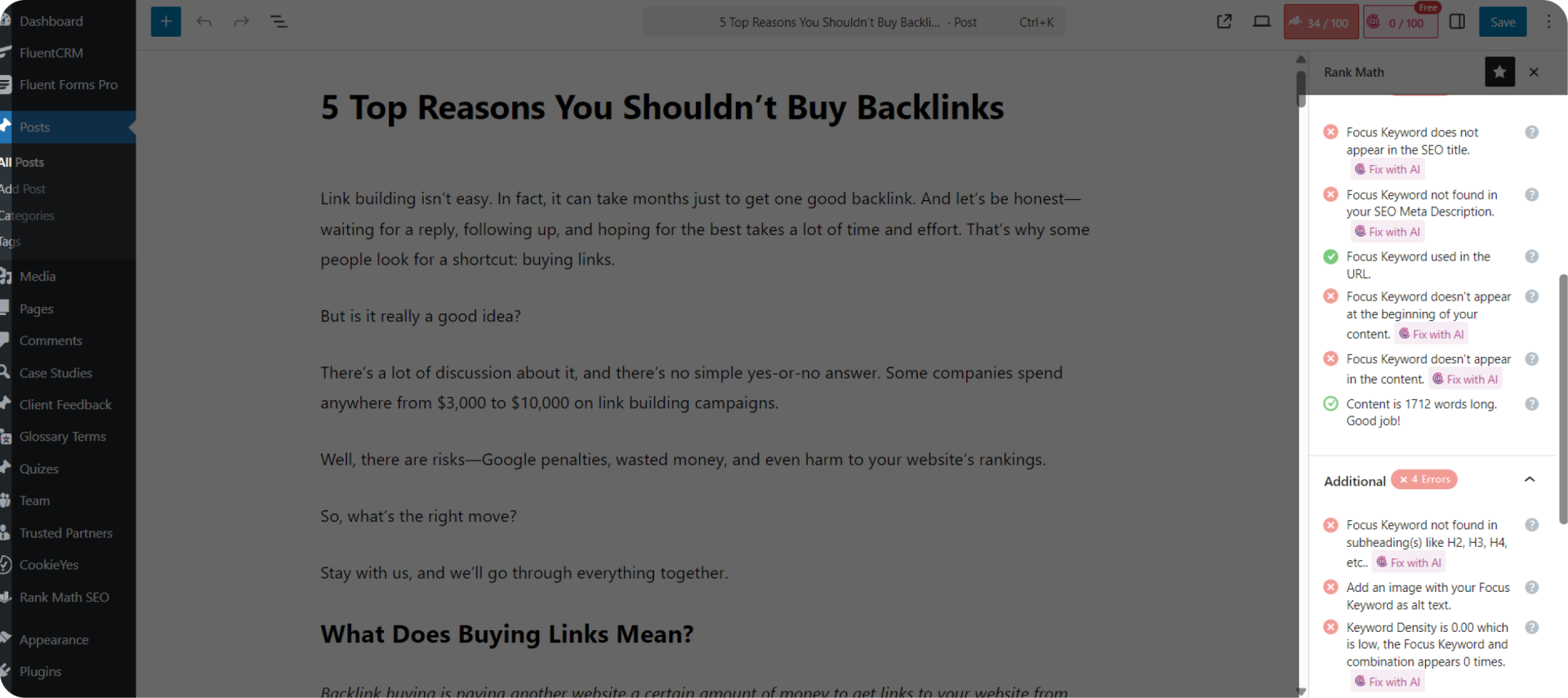You’ve have a blog post to write, a focus keyword to rank for, and a blank page staring back at you.
But then the question hits: “How many times should I use that keyword?”
Use it too little, and Google might overlook your content. Use it too much, and it starts sounding spammy.
That’s where keyword density comes in. In this article, we’ll explore what it is, how it impacts your SEO, and share our best tips to find the right balance so your content ranks well and reads naturally.
What is Keyword Density?
Keyword density is a ratio or percentage that shows how many times a target keyword appears within content in relation to the overall word count.
For example, if you’ve written a blog and used the target keyword 10 times, this shows the keyword’s frequency, which is exactly what keyword density is all about.
But is that too much, too little, or just right? We’ll break it down shortly.
Does Keyword Density Matter?
While keyword density is not a ranking factor, you should not ignore it, as it is important for your SEO.
If you barely use your target keyword, search engines might not understand what your content is about. But if you overdo it, you risk keyword stuffing, which violates Google’s spam policies.
Here’s what Google Search Central adds.
“The first one or two times you mention a word, then that might help with your ranking, absolutely. But just because you say it seven or eight times, that doesn’t mean it will necessarily help your rankings.”
So, yes keyword density matters, since it helps search engines understand if your content is relevant and what it is about in general.
But there’s more. The right keyword frequency also helps the user experience. Imagine a reader comes across your article, and all they read is a text stuffed with keywords. The result? Higher bounce rate and low engagement.
However, naturally incorporating keywords into your existing content fixes this issue and makes users stick around longer.
The takeaway? Keyword density matters. While not directly but, it still helps your SEO efforts.
What is a Good Keyword Density?
Generally, 1-2% is considered to be good keyword density.
But if you’re struggling to include a keyword naturally, don’t force it into places where it doesn’t fit just to meet a number.
It only harms your SEO, disrupts content flow, and makes it hard to read. So, if your keyword usage is a bit low, don’t stress out. It’s definitely not the end of the world.
The best approach? We highly recommend using keywords in a natural way. At the end of the day, your content is meant for people first, not just search engines.
How to Calculate Keyword Density?
Keyword density calculation is super easy even when you do it manually.
All you need to do is divide the number of times a target keyword is used on your content by the total number of words on the page and multiply 100 to get a percentage․
Keyword Density (%) = (Keyword Uses ÷ Total Word Count) × 100
For example, if you have written a 3000 word-long article and used your target keyword 12 times, all you have to do is divide 12 by 3000 and multiply by 100, which is 0.4.
Not a fan of math? No worries, I’m not either. You can use a free keyword density tool like the one from SEO Review Tools.
Simply enter your blog URL or input blog text and click “Perform check.” For instance, when we ran one of our blogs on link reclamation through the tool, it showed the density of different phrases (see the video screenshot below).
Just go through all of the results to spot any keywords that appear more than needed in your content. This way, you can easily identify keyword stuffing and fix it immediately.
How to Check Keyword Density With Yoast SEO
If you run a WordPress website, one thing we recommend is using the Yoast SEO plugin. It provides helpful recommendations regarding how to optimize your content for search engines.
And yes, it also checks if your keyword density is on point. Here’s how to find it:
When you’re editing a draft, look at the top-right corner of the screen. You’ll see the Rank Math icon. Click it to view a list of basic SEO checks.
Scroll down to the “Additional” section. There, you’ll find the keyword density score.
For example, in our article about orphan pages, the focus keyword appeared 21 times. It’s marked green, meaning that the keyword density is in a good range.

However, when you don’t meet the number, it is marked red. As you can see, in our link building templates article, we’ve used the keyword only 5 times, which is low in relation to the overall word count.

What’s also great about this plugin is that it tells you exactly where to add your target keyword to improve your keyword density.

In the screenshot, you can see the plugin highlights where the keyword is missing, such as the SEO title, meta description, introduction, headings, and body of your content. These elements are easy to overlook when you’re focused on writing.
But luckily, nothing escapes the eye of Yoast SEO, which makes it a highly effective tool for content optimization.
Keyword Density Done Right: Tips That Work
We’ve written a lot of content, and here’s what we’ve learned about finding the right balance with keywords while optimizing for search engines.
- If your keyword density is low, it means you should be targeting the keyword a bit more. Make sure it’s included in key places, like your headings, meta tags, alt texts, introduction, and URL slug. Also, integrate the keyword naturally within the body of your content, especially in places where it’s missing and could fit well.
- If you’ve used a certain keyword too much, we recommend going through the blog again and removing a few of them manually from the text. This way, your text won’t look spammy to users and search engines.
- Always prioritize the user experience. Write for people, not just for search engines. Google’s recent updates highlight this again. Content that adds value to readers ranks higher and performs better than over-optimized content.
- Once you’re done writing, don’t rush to publish. Double-check your article manually or use keyword density tools to make sure your keyword use is balanced.
These easy steps can take you one step closer to writing content that’s both SEO- friendly and genuinely valuable to your audience.
Wrapping Up
While it may be tempting to use the same keyword over and over, it’s always useful to mind the keyword density.
It’s not about how many times you use the focus keyword, but where and how. If it feels natural and relevant, then you are on the right track.
And, if you’re feeling overwhelmed with writing and using the keywords the right way, you can leave your content creation to us. Curious how? Our full SEO services page is a good place to start or you can simply book a call with us to discuss how we can help your content strategy.
FAQ about keyword density
Is keyword density a ranking factor?
No, keyword density is not a ranking factor. However, it plays an important role in writing well-balanced and SEO-optimized content.
How many keywords per 1000 words?
At 1-2% keyword density, you can include your target keyword about 10 to 20 times in a 1,000-word article.
What is the keyword density of 800 words?
At 1-2% keyword density, you can use your target keyword about 10 to 16 times in a 800-word article.

Quiz Time
Let's put your knowledge to the test.
Leave your email below to get a SayNine certificate!
Are you sure?



